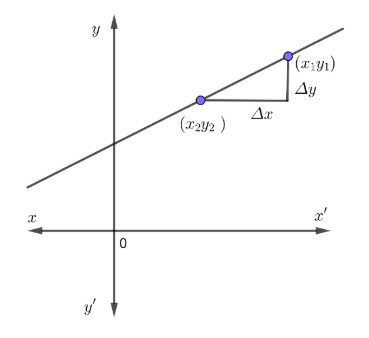
The parallelism condition for two straight lines one of which is specified by the equation $ax+by+c=0$ the other being represented parametrically by $x=\alpha t+\beta ,y=\gamma t+\delta $ is given by
(a) $\alpha \gamma -b\alpha =0,\beta =\delta =c=0$
(b) $a\alpha -b\gamma =0,\beta =\delta =0$
(c) $a\alpha +b\gamma =0$
(d) $a\gamma =b\alpha =0$
Answer
608.4k+ views
Hint: Use parametric equations to find the straight line. Take the slope of both equations to form the required equation.
Given lines are $ax+by+c=0.................\left( 1 \right)$
$x=\alpha t+\beta ................\left( 2 \right)$
$y=\gamma t+\delta .............\left( 3 \right)$
One of the straight line specified is $ax+bx+c=0$
We have to find other straight line by using the equation (2) and (3)
So as to complete the parallelism condition; By cross multiplying:
$\begin{align}
& x=\alpha t+\beta \\
& y=\gamma t+\delta \\
& \dfrac{x}{y}=\dfrac{\alpha t+\beta }{\gamma t+\delta } \\
& \Rightarrow x\left( \gamma t+\delta \right)=y\left( \alpha t+\beta \right) \\
\end{align}$
Divide throughout by $t$
\[\begin{align}
& \dfrac{x\left( \gamma t+\delta \right)}{t}=\dfrac{y\left( \alpha t+\beta \right)}{t} \\
& \Rightarrow \gamma \alpha +\dfrac{\delta x}{t}=\alpha y+\dfrac{\beta y}{t} \\
\end{align}\]
$\Rightarrow \left( \gamma x-\alpha y \right)+\left( \dfrac{\delta x}{t}-\dfrac{\beta y}{t} \right)=0...................\left( 4 \right)$
Slope ${{m}_{1}}=\alpha =\dfrac{{{a}_{1}}}{{{b}_{1}}}=\dfrac{x}{t},$ for equation (1)
Slope ${{m}_{2}}=\gamma =\dfrac{{{a}_{2}}}{{{b}_{2}}}=\dfrac{y}{t}$ , for equation (2)
Substituting the slope on equation (4)
${{\gamma }_{x}}-\alpha y+\alpha \delta -\gamma \beta =0...............\left( 5 \right)$
The equation (5) is the 2nd straight line to fulfil parallelism condition.
$ax+by+c=0$
$\gamma x-\alpha y+\alpha \delta -\gamma \beta =0$ (Equation 5)
$\therefore $ The required equation is found from the slope of the equation.
From this by considering that the slope of both the equations are similar i.e., now comparing the common equation and equation (5).
$\begin{align}
& ax+by+c=0 \\
& \gamma x-\alpha y+\alpha \delta -\gamma \beta \\
& here\text{ }{{\text{a}}_{1}}=a\text{ }{{\text{a}}_{2}}=\gamma \\
& \text{ }{{\text{b}}_{1}}=a\text{ }{{\text{b}}_{2}}=\alpha \text{ } \\
\end{align}$
We can consider that
\[\dfrac{{{a}_{1}}}{{{a}_{2}}}=\dfrac{{{b}_{1}}}{{{b}_{2}}}\Rightarrow \dfrac{a}{\gamma }=\dfrac{b}{-\alpha }\]
Now cross multiplying them we get,
\[-a\alpha =b\gamma \Rightarrow a\alpha +b\gamma =0\]
Thus we received the required equation.
So option C is correct.
Note: The slope of a line characterizes the direction of a line. In this question it is important to find the slope to fulfil the conditions of parallelism.
To find the slope, you need to divide the difference of $y$-coordinate of two points on a line by the difference of the $x$-coordinate of those same two points.
$\therefore slope=\dfrac{{{y}_{2}}-{{y}_{1}}}{{{x}_{2}}-{{x}_{1}}}$

Or, slope can be found also using
$\Delta $ Notation,
$y$-coordinate $=\Delta y$
$x$-coordinate $=\Delta x$
$\therefore slope=\dfrac{\Delta y}{\Delta x}$
$\dfrac{\Delta y}{\Delta x}=\dfrac{{{y}_{2}}-{{y}_{1}}}{{{x}_{2}}-{{x}_{1}}}=$slope of line
Given lines are $ax+by+c=0.................\left( 1 \right)$
$x=\alpha t+\beta ................\left( 2 \right)$
$y=\gamma t+\delta .............\left( 3 \right)$
One of the straight line specified is $ax+bx+c=0$
We have to find other straight line by using the equation (2) and (3)
So as to complete the parallelism condition; By cross multiplying:
$\begin{align}
& x=\alpha t+\beta \\
& y=\gamma t+\delta \\
& \dfrac{x}{y}=\dfrac{\alpha t+\beta }{\gamma t+\delta } \\
& \Rightarrow x\left( \gamma t+\delta \right)=y\left( \alpha t+\beta \right) \\
\end{align}$
Divide throughout by $t$
\[\begin{align}
& \dfrac{x\left( \gamma t+\delta \right)}{t}=\dfrac{y\left( \alpha t+\beta \right)}{t} \\
& \Rightarrow \gamma \alpha +\dfrac{\delta x}{t}=\alpha y+\dfrac{\beta y}{t} \\
\end{align}\]
$\Rightarrow \left( \gamma x-\alpha y \right)+\left( \dfrac{\delta x}{t}-\dfrac{\beta y}{t} \right)=0...................\left( 4 \right)$
Slope ${{m}_{1}}=\alpha =\dfrac{{{a}_{1}}}{{{b}_{1}}}=\dfrac{x}{t},$ for equation (1)
Slope ${{m}_{2}}=\gamma =\dfrac{{{a}_{2}}}{{{b}_{2}}}=\dfrac{y}{t}$ , for equation (2)
Substituting the slope on equation (4)
${{\gamma }_{x}}-\alpha y+\alpha \delta -\gamma \beta =0...............\left( 5 \right)$
The equation (5) is the 2nd straight line to fulfil parallelism condition.
$ax+by+c=0$
$\gamma x-\alpha y+\alpha \delta -\gamma \beta =0$ (Equation 5)
$\therefore $ The required equation is found from the slope of the equation.
From this by considering that the slope of both the equations are similar i.e., now comparing the common equation and equation (5).
$\begin{align}
& ax+by+c=0 \\
& \gamma x-\alpha y+\alpha \delta -\gamma \beta \\
& here\text{ }{{\text{a}}_{1}}=a\text{ }{{\text{a}}_{2}}=\gamma \\
& \text{ }{{\text{b}}_{1}}=a\text{ }{{\text{b}}_{2}}=\alpha \text{ } \\
\end{align}$
We can consider that
\[\dfrac{{{a}_{1}}}{{{a}_{2}}}=\dfrac{{{b}_{1}}}{{{b}_{2}}}\Rightarrow \dfrac{a}{\gamma }=\dfrac{b}{-\alpha }\]
Now cross multiplying them we get,
\[-a\alpha =b\gamma \Rightarrow a\alpha +b\gamma =0\]
Thus we received the required equation.
So option C is correct.
Note: The slope of a line characterizes the direction of a line. In this question it is important to find the slope to fulfil the conditions of parallelism.
To find the slope, you need to divide the difference of $y$-coordinate of two points on a line by the difference of the $x$-coordinate of those same two points.
$\therefore slope=\dfrac{{{y}_{2}}-{{y}_{1}}}{{{x}_{2}}-{{x}_{1}}}$

Or, slope can be found also using
$\Delta $ Notation,
$y$-coordinate $=\Delta y$
$x$-coordinate $=\Delta x$
$\therefore slope=\dfrac{\Delta y}{\Delta x}$
$\dfrac{\Delta y}{\Delta x}=\dfrac{{{y}_{2}}-{{y}_{1}}}{{{x}_{2}}-{{x}_{1}}}=$slope of line
Recently Updated Pages
Why are manures considered better than fertilizers class 11 biology CBSE

Find the coordinates of the midpoint of the line segment class 11 maths CBSE

Distinguish between static friction limiting friction class 11 physics CBSE

The Chairman of the constituent Assembly was A Jawaharlal class 11 social science CBSE

The first National Commission on Labour NCL submitted class 11 social science CBSE

Number of all subshell of n + l 7 is A 4 B 5 C 6 D class 11 chemistry CBSE

Trending doubts
What is meant by exothermic and endothermic reactions class 11 chemistry CBSE

10 examples of friction in our daily life

One Metric ton is equal to kg A 10000 B 1000 C 100 class 11 physics CBSE

1 Quintal is equal to a 110 kg b 10 kg c 100kg d 1000 class 11 physics CBSE

Difference Between Prokaryotic Cells and Eukaryotic Cells

What are Quantum numbers Explain the quantum number class 11 chemistry CBSE




